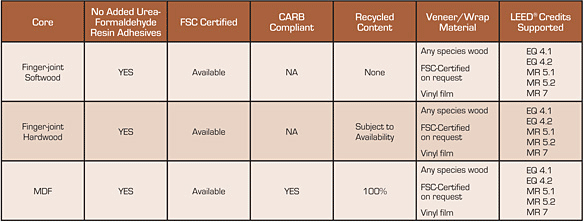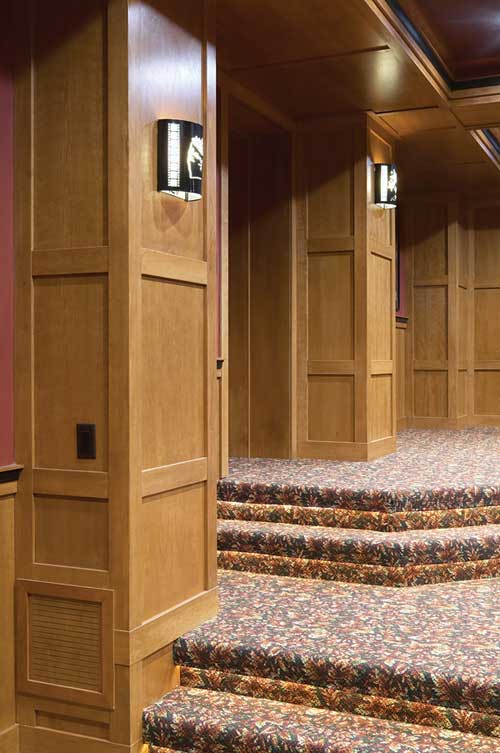Specifying Real Wood Veneer: Versatile, Economical, Sustainable
Companies that mill solid hardwood mouldings from clear lumber can have up to 60 percent utilization waste with a significant amount of off-fall as they work to meet a specification.
 |
Veneered mouldings and millwork support LEED credits. Source: Contact Industries |
In contrast, the profile wrapping process is known to achieve a 95 percent utilization rate of all the raw material wood in usable products. In some instances, manufacturers have used the remaining 5 percent waste in balers to generate electricity that is fed into the local power grid, resulting in full utilization of the resource.
Enhanced Sustainability. The inherent sustainability of veneered products can be assured through the specification and use of certified substrates and veneers.
To ensure the highest sustainability quotient, architects should confirm that any of the wood-based core materials-- including softwood, hardwood, medium density fiberboard (MDF) and laminated veneer lumber (LVL)-- are certified by the Forest Stewardship Council (FSC) or the Sustainable Forest Initiative (SFI).
FSC chain of custody certification provides assurance regarding the production path taken by raw materials from the forest to the consumer, including all stages of processing, transformation, manufacturing and distribution. Most any veneer and core wood can be sourced with FSC forest certification, and products thus certified can be used to support needed credits in up to six different U. S. Green Building Council Leadership in Energy and Environmental Design (LEED) categories.
 |
Cherry veneer wrapped mouldings resulted in a 30 percent savings over solid wood at the Hills of Troy development in Wisconsin. Photo courtesy of Contact Industries |
Installation Considerations. Advanced finger jointing technology with grain-matching veneer has enabled manufacturers to provide profile wrapped products in 14-foot, 16-foot and, now, 18-foot lengths –
This result difficult to achieve in both quantity and quality when using solid hardwood lumber.
With these lengths, most surfaces will require no end joints, resulting in a clear, defect-free board stretching the full length of the walls and ceilings in many applications, significantly reducing the occurrence of joints in all applications.
Ceiling applications, in particular, are much simpler to handle, and easier to install, when veneered boards are long enough to span the entire room.
Long-length products can be installed in one piece, so installation is faster and less costly than random length solid mouldings because there are fewer joints to scarf and nail.
In addition, veneer profile wrapped products require minimal surface preparation, result in fewer seams, and do not require pre-drilling as most solid hardwood mouldings would.
And because they can be produced to specified lengths, job site waste is significantly reduced, as is the impact on the environment and the wood fiber resource.
Reductions in installed cost of wrapped products versus solid wood equivalents can be dramatic. The Hills of Troy, a master planned community located in Wisconsin near the Twin Cities, is a 270-acre development with more than 70 acres devoted to conservation and crisscrossed by scenic nature trails and recreation areas. Builders of the homes sought to complement the natural exterior environment, and specified hardwood veneered mouldings using a finger-jointed pine substrate. Some 5,000 lineal feet of cherry veneer-wrapped mouldings including crown, base, window and door trim, cove ceiling and stair parts throughout each house were used. The savings on the installed cost of the wrapped products compared to solid cherry hardwoods: 30 percent.









